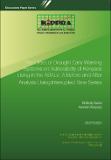| dc.description.abstract | Kenya has about 80 per cent of its land mass falling within the Arid and Semi-Arid
Lands (ASALs), therefore largely prone to drought events. Science, Technology
and Innovation (ST&I) has been incorporated in Kenya’s drought management
through drought early warning systems (DEWS). This study sought to determine
the effect of DEWS on vulnerability levels of people living in the ASALs, who are
most affected by droughts through food insecurity. A comparison of the situation
before and after introduction of DEWS, using multigroup Interrupted Time Series
(ITS) analysis was undertaken. Data from the National Drought Management
Authority (NDMA) database on the number of people facing food insecurity in
the 23 ASAL counties of Kenya over the years was utilized. The study found that
Turkana was the worst affected county in the ASALs with a 41 per cent increase in
food insecure population before DEWS, and 20 per cent increase in food insecure
population after DEWS. There was, however, a significant marginal reduction in
number of people facing food insecurity in Turkana - a reduction of 20 per cent
post-DEWS. However, DEWS effect was insignificant in the counties of Garissa,
Marsabit, Isiolo, Narok, Samburu, Taita Taveta and Tana River. Two counties
recorded a significant reduction in food insecure populations with the adoption
of DEWS. Mandera recorded a 67 per cent reduction in food insecure populations
over time after DEWS adoption, and Laikipia recorded a 45 per cent reduction in
food insecure populations immediately DEWS were adopted. We conclude that
DEWS are significant in reducing vulnerability levels of populations living in the
ASALs, as illustrated from regression results. However, more effort is needed in
increasing its effectiveness | en |

